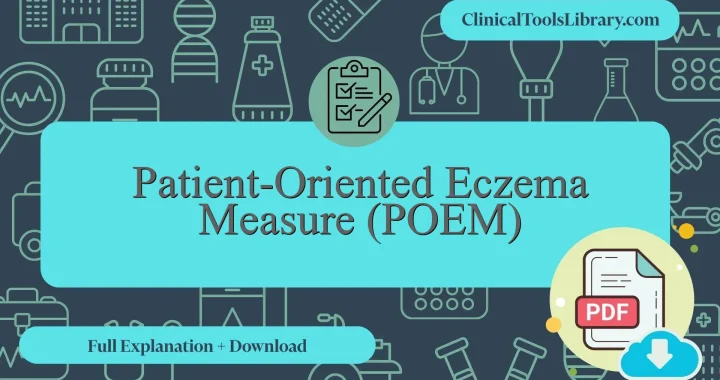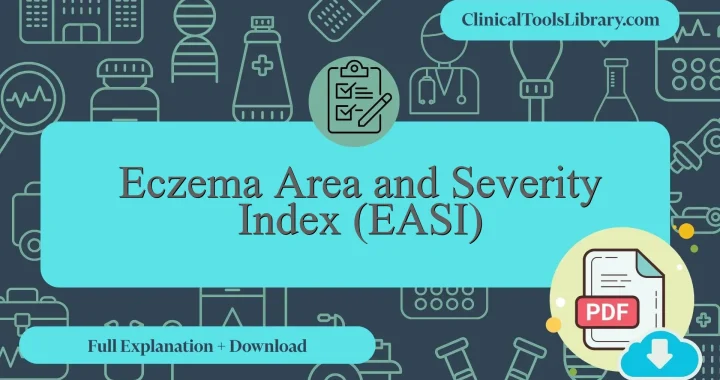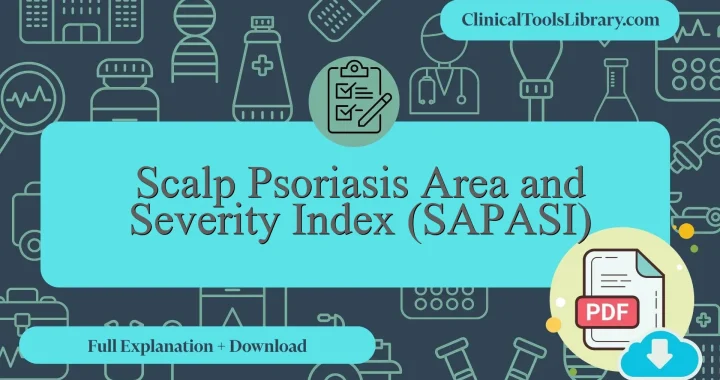In this article, we explain everything you need to know about the Patient-Oriented Eczema Measure (POEM). We will cover the aspects it evaluates, the target population, a detailed step-by-step explanation, and how to interpret its results. Additionally, we will dive into the scientific evidence supporting this tool (diagnostic sensitivity and specificity) in clinical assessment. You will also find official and unofficial sources available for download in PDF format.
What does the Patient-Oriented Eczema Measure (POEM) assess?
The Patient-Oriented Eczema Measure (POEM) is a validated tool designed to assess the severity and frequency of symptoms experienced by patients with eczema. It focuses on patient-reported outcomes related to itching, sleep disturbance, and skin dryness over the previous week. The main purpose of POEM is to provide a reliable measurement of disease impact from the patient’s perspective, facilitating both clinical assessment and monitoring treatment responses. Unlike objective tools such as the EASI score or the ISGA score eczema, POEM emphasizes subjective symptomatology, making it essential for a comprehensive evaluation of atopic dermatitis. The availability of resources such as the patient-oriented eczema measure pdf and the POEM score calculator aids clinicians in quantifying the POEM eczema score accurately, supporting evidence-based management decisions.
For which type of patients or populations is the Patient-Oriented Eczema Measure (POEM) intended?
The Patient-Oriented Eczema Measure (POEM) is primarily indicated for individuals diagnosed with atopic dermatitis, spanning pediatric to adult populations. It serves as a validated, patient-reported outcome instrument designed to assess disease severity from the patient’s perspective, capturing symptoms such as itch, sleep disturbance, and skin dryness over the previous week. Clinically, POEM is most useful in routine dermatological and primary care settings to monitor response to treatment and guide management decisions. Compared to clinician-reported tools like the Eczema SCORing tool (EASI) or the ISGA score eczema, POEM facilitates the integration of subjective symptom burden into clinical assessment. The availability of resources such as the POEM score calculator and patient-oriented eczema measure PDF supports standardized use, enabling consistent tracking of disease activity and improving patient-centered care outcomes.
Step-by-Step Explanation of the Patient-Oriented Eczema Measure (POEM)
The Patient-Oriented Eczema Measure (POEM) consists of seven items designed to assess the severity of atopic eczema symptoms over the past week. Each item queries the frequency of specific symptoms such as itching, sleep disturbance, bleeding, and skin cracking, with response options ranging from “No days” (0 points) to “Every day” (4 points). The total score, calculated by summing individual item responses, ranges from 0 to 28, providing a quantitative measure of disease impact from the patient’s perspective. This format allows for consistent monitoring of symptom fluctuations and treatment efficacy in clinical practice and research settings.
Patient-Oriented Eczema Measure (POEM) PDF Resources and Score Calculator for Eczema Assessment
Downloadable resources for the Patient-Oriented Eczema Measure (POEM) are available below in both the original and English versions, provided in PDF format. These tools facilitate accurate assessment of eczema symptoms from the patient’s perspective and support clinicians in monitoring disease severity. The availability of the POEM score calculator enhances practical application in clinical settings by offering standardized evaluation metrics.
How to interpret the results of the Patient-Oriented Eczema Measure (POEM)?
The Patient-Oriented Eczema Measure (POEM) quantifies the severity of atopic dermatitis symptoms over the previous week using a 7-item questionnaire, each scored from 0 to 4, yielding a total score ranging from 0 to 28. Interpretation relies on established reference ranges: 0–2 indicates clear or almost clear skin, 3–7 corresponds to mild eczema, 8–16 reflects moderate severity, 17–24 severe, and 25–28 very severe disease. For example, a POEM score of 12 suggests moderate symptomatology, guiding clinicians to consider intensifying treatment or monitoring. In practical terms, these values enable healthcare professionals to objectively assess symptom burden, track treatment response, and make informed decisions regarding therapy adjustments, thereby enhancing patient-centered care for individuals with eczema.
What scientific evidence supports the Patient-Oriented Eczema Measure (POEM) ?
The Patient-Oriented Eczema Measure (POEM) was developed in 2004 to provide a reliable, patient-centered tool for assessing the severity of atopic dermatitis symptoms. Validation studies have demonstrated strong internal consistency (Cronbach’s alpha > 0.9) and good test-retest reliability, confirming its stability over time. POEM’s construct validity was established through correlations with other established clinical assessments such as the Scoring Atopic Dermatitis (SCORAD) index and objective clinical evaluations. Furthermore, the measure has been cross-validated in multiple languages and diverse patient populations, supporting its international applicability. Its responsiveness to clinical change has been evidenced in randomized controlled trials, reinforcing its utility in both clinical practice and research settings for monitoring disease activity and treatment outcomes in eczema.
Diagnostic Accuracy: Sensitivity and Specificity of the Patient-Oriented Eczema Measure (POEM)
The Patient-Oriented Eczema Measure (POEM) demonstrates a sensitivity ranging from approximately 80% to 90% in detecting clinically significant atopic eczema symptoms, indicating its effectiveness in identifying affected individuals. Specificity values are generally reported between 70% and 85%, reflecting its ability to distinguish patients without active disease from those with ongoing symptoms. These metrics vary depending on the population studied and the reference standards applied but consistently support POEM’s utility as a reliable patient-reported outcome measure for monitoring disease severity and treatment response in eczema management.
Related Scales or Questionnaires
The Patient-Oriented Eczema Measure (POEM) is often compared with other validated instruments such as the Eczema Area and Severity Index (EASI) score, the Scoring Atopic Dermatitis (SCORAD) tool, and the Investigator’s Static Global Assessment (ISGA) score for eczema. While EASI and SCORAD focus primarily on clinician-assessed severity and extent of disease, POEM emphasizes patient-reported symptoms and their impact on daily life, providing a valuable complement to objective measurements. The EASI score offers sensitivity to treatment changes but requires clinician expertise, whereas SCORAD incorporates both clinical signs and subjective symptoms, making it comprehensive but somewhat time-consuming. The ISGA score is simpler but less detailed. All these scales and questionnaires, including the patient-oriented eczema measure PDF and POEM score calculator, are thoroughly explained and available for download on ClinicalToolsLibrary.com, facilitating informed selection tailored to clinical or research needs.




